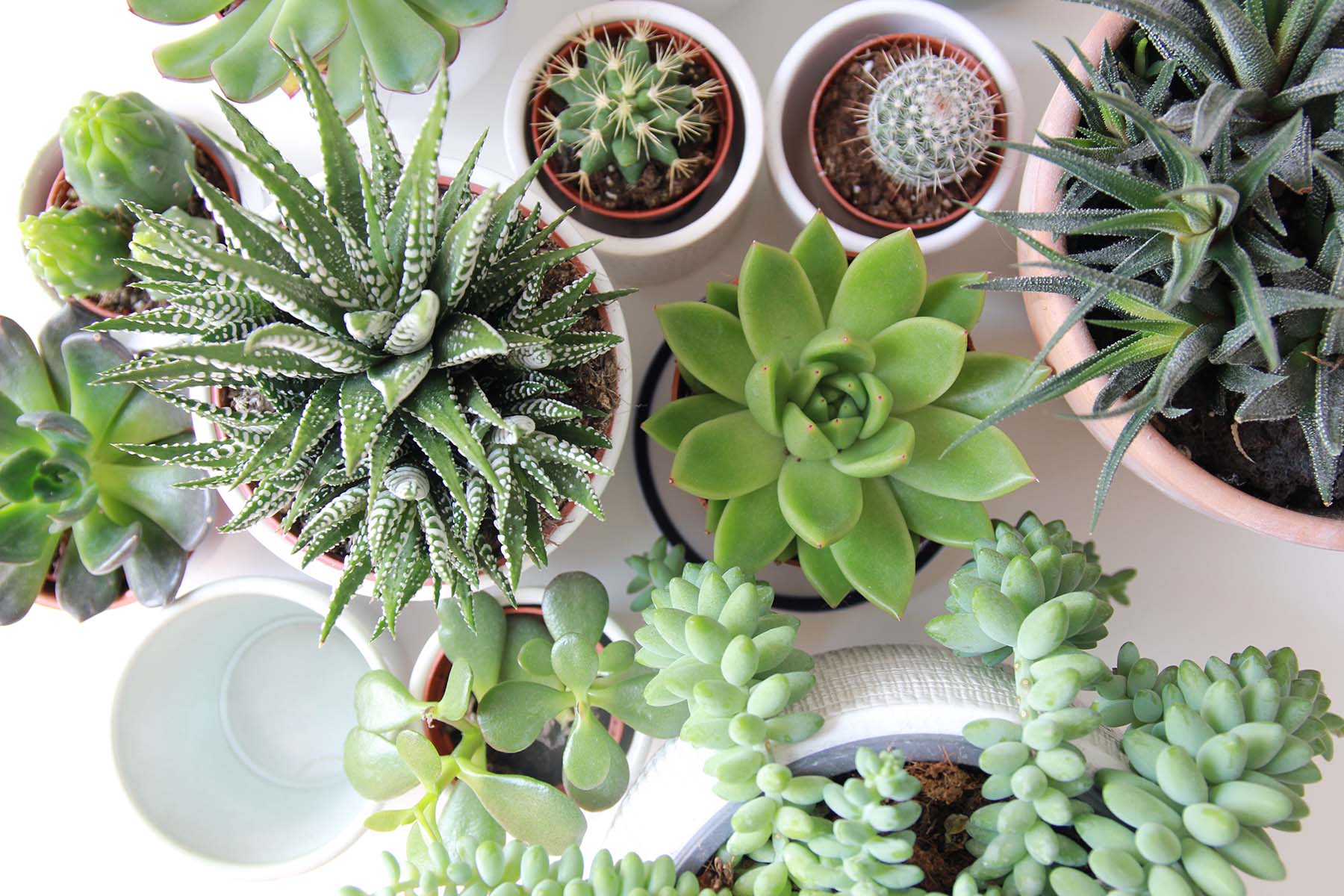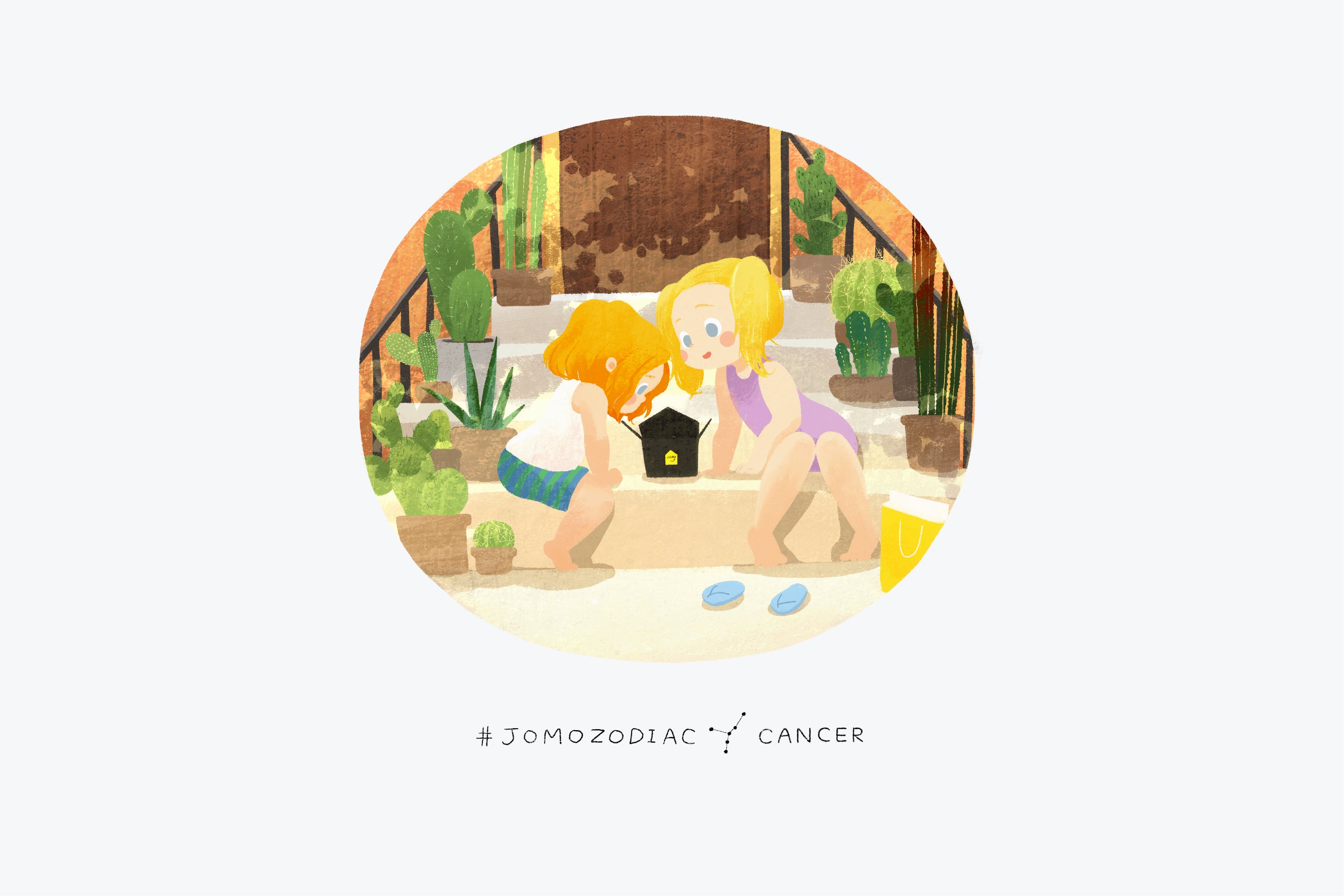
How to Take Care of Your Succulents & Cacti
Succulents, some of the most beautiful, yet often heartbreaking, houseplants to own. With an incredibly diverse repertoire of varieties on hand at almost any greenhouse, plant boutique, or grocery store, it is no wonder why we are all drawn to them. They come in greens, reds, pinks, pale blues, purples and creams, with juicy leaves and succulent stems full of stored moisture, which is why they are so drought-tolerant. Their fleshy leaves allow them to survive for long periods of time on a limited water supply, which makes sense considering their natural habitats are steppes, semi-deserts and deserts. Other than Antarctica, succulents can be found within each continent!
🌵
Fun fact: Almost all cacti are succulents, but not all succulents are cacti. Just as there is among other succulents, there is also a huge variation in species in the cacti sub-category. The difference with cacti is that even though they occur in a wide range of shapes and sizes, they have generally lost all of their true leaves and retain only spines, which are highly modified leaves.
So, if they are such popular houseplants, known as being low maintenance, then why are succulents also known to have a relatively tricky track record? Well, this is because they definitely require the proper growing conditions to retain their shape and health. Once their environment is accurately set up, they can be quite easy-going and will produce plenty of beautiful new growth for you over time. Therefore, when looking to purchase a succulent for your home, it would be very wise to consider the needs of each variety and select accordingly.
🐌
Keep in mind that the majority of succulents are quite slow growers.
Some of the most common succulent genera you will find in houseplant collections, besides cacti, include, but are not limited to:
Echeveria:
These come in all sizes and colours, but they are generally stunning thick-leaved rosettes. Some popular examples would be Echeveria 'Lola', Echeveria 'Perle von Nurnberg', Echeveria 'Topsy Turvy', and Echeveria 'Dusty Rose'

Aloe:
The most widely known species of Aloe is known as Aloe vera, or "true Aloe", since it has been cultivated as the standard source for assorted pharmaceutical purposes, such as for treating sunburns. More examples would be Tiger Jaws Succulent and Tiger Aloe.

Haworthia:
Also a part of the Aloe family, Haworthia are often classified separately since they have a rather unique look and have adapted to handle lower light levels, due to their fleshy, dark green leaves. Our Regular Haworthia Mystery Box and Big Haworthia Mystery Boxes will provide you with some of the more popular species. Gasteria are also similar, with a slightly more "warty" look!

Sedum:
This is a large genus of plants, members of which are commonly known as stonecrops. Some Sedums that you may recognize would be the trailing Sedum Morganianum, or Donkey Tail succulent, and Sedum Burrito, or Burro's Tail succulent, which has smaller, rounder leaves than its Donkey cousin.

Senecio:
Succulents in the Senecio genus produce flowers that are daisy-like and yellow, or red-orange puffs, which dry into dandelion-like tufts. Their leaves will range from sky blue to shades of green. You may know them according to their more common names, such as String of Dolphins, String of Pearls, String of Pickles, Pickle Cactus, and Senecio Mikanoides.

Kalanchoe:
Popular houseplants due to their rapid growth and easy-care attitude, Kalanchoe is a highly diverse genus with many looks and textures. Some of the most common varieties would be Mother of Thousands and Flapjack Kalanchoe.
Crassula:
Even if you think you don't own any succulents yourself, you most likely do, in the form of the classic Jade Plant, or Crassula Ovata, which are incredibly common due to their cultural heritage, accessibility, and low maintenance care. There are also plenty of other species in the Crassula genus, such as Coral Jade and Crassula Spiralis Black Curl.

Rhipsalis:
Rhipsalis is actually a genus of epiphytic flowering plants in the cactus family, often referred to as Mistletoe Cactus. The degree of succulence varies among the species, such as Rhipsalis Pilocarpa, but the majority are missing any form of spines, unlike other cacti types. They are slightly more forgiving of lower light.

Lithops:
Finally, we have the Lithops, or Living Stones, genus. Known for their weird looks, they consist of one or more pairs of bulbous, almost fused leaves opposite to each other and hardly any stem. The leaves are mainly buried, with a partially or completely translucent top known as a leaf window which allows light to enter for photosynthesis.

Plant Tip: The biggest downfalls in succulent care are 1) caring for them too much and 2) not selecting the correct plant for your environment.
There are many different species and cultivars of succulents and cacti that exist, it is simply important to find the correct species for you and your home. Consider how much light, especially direct sunlight, that you have available and purchase accordingly! Don't worry though, we will cover all of the necessary tips and tricks to keeping your succulents happy and healthy in the following care guide, as well as different options for varying light levels.
Light Requirements
The majority of succulents require very bright light for at least 6 hours of the day, and often very, strong, direct bright light. Not only does it help them to keep their beautiful colours, but it also assists in keeping them full and compact, while encouraging little offsets, or babies. This is why it is so important to assess your home environment and see what spaces you have available for succulents. Do you have bright, sunny windowsills? Do you have large windows with an unobstructed view of the sky and sun? Do you have grow lights to supplement the lack of sun in certain windows or through certain periods of the year?
☀️
South, East, and West-facing windows are the optimal windows to keep succulents in.
If you lack any bright windowsills, grow lights are a great alternative to supplement this lack of bright light! Grow lights of certain spectrums can actually bring out the pinks and purples of certain varieties as well, which sunlight won't naturally do by itself. On the other hand, when succulents receive an abundant amount of intense light during the summer months, they may turn pale and go dormant. If this happens, simply move your plant a little further from the window. Some succulents love direct sunlight, others just like very bright light, always double-check first before purchasing.
💡
Just like any other plant, succulents will begin to grow towards the light, so if they are only receiving light from one side, consider rotating your plant every week or so to encourage even and straight growth.
When succulents are placed in light levels that are too low, they often become what is known as "leggy". Echeveria, or rosette-forming succulents, are especially notorious for becoming etiolated, or pale and drawn out from the lack of bright light. The growth each plant does produce will be tall and stretched out, reaching for whatever light it can get, with large spacing between the leaves rather than the lush, compact growth we gravitate towards them for. Essentially, succulents should be allocated prime window space, right along a windowsill or as close to the windowsill as possible. Any distance between them and the window will most certainly cause some sort of stretched growth, which is why we emphasize choosing plants that will suit your home.
🌥
The best succulent options for lower light levels are Haworthia, Gasteria, and Aloe, seeing as they possess dark green leaves that can still photosynthesize with a little less light and are not as prone to leggy growth. However, they will almost always prefer brighter light if they had a choice.
When growth does become stretched out, moving your plant closer to the window and pruning it back, still ensuring there are leaves left on it, should correct the problem. That being said, succulents can also grow in intricate shapes if they are allowed to grow as they are and receive bright enough light. It is natural for their older leaves to dry up and fall off eventually, just as it is normal for any other houseplant to do so. As long as the new growth is staying relatively compact, you can remove the bottom leaves and let the plant morph into what it wants to be! All plants will change over time so feel free to let them be as they are, nature will rarely stay in the "perfect" shape forever.
Watering Requirements
The number one way to kill succulents is by watering them too frequently. Sure, they can lose their leaves and become stretched out from the lack of light, but they will still have somewhat of a life. However, if they receive too much water too often, they will not survive in the long run. As mentioned above, succulents have very thick, juicy stems and leaves, just as their name states, meaning they can survive for long periods of time on the water stored in their leaves. This is why it is almost always recommended to wait until their soil is completely dry before watering them again. During their dormancy throughout the cooler months, where they show little to no signs of new growth, it is extremely important to avoid overwatering!
Watering Tip: Wait until their leaves become a little wrinkly, this is often a good indication that they are thirsty. Excessive shrivelling can mean you are waiting too long in between waterings but it is better to water less often than more often.
This is why keeping your plant in the proper soil, as well as in the proper lighting, is very important, making sure the soil does not stay too wet for too long. A well-draining soil will have pumice, perlite and sand in it to avoid excessive water retention. A shallow pot with drainage holes is also essential, providing an exit for extra water as well as allowing for proper airflow, not allowing the soil to stay moist for longer than necessary. Open, glass terrariums are a common type of container to keep succulents in (it does create a beautiful succulent garden if done correctly), but these should only be used if you are extremely confident in your watering abilities!
📋
The majority of succulents won't need repotting very often, as they do not grow too quickly and their roots are very fine. However, when it does come time to repot, make sure the pot is not too big or deep, and that it has a drainage hole. Their roots are very fragile so be gentle with them when upsizing their home! For more information, please see our Repotting Guide.
When you're sure it is time to water, using tap water will be just fine, simply make sure you are watering your plant thoroughly and not only misting the top of the soil as this can cause brittle roots. We want the roots to reach down as deeply as possible into the soil, especially since succulents generally have fairly shallow root systems to begin with, and only keeping the surface of the soil damp will not encourage the roots to do so. As you water, use a watering can with a thing long spout that will avoid getting any water on or between the leaves, this can lead to unhealthy bacteria and rot.
✂️
It is common to propagate different succulents via stem and leaf cuttings, offshoots, or in water, but you can read more about this in our Propagation Series.
Allow any extra water to drain out of the pot and dump it, rather than letting the pot sit in this excess water since we know they are especially susceptible to overwatering. If the soil does not seem to be absorbing the water, you can either aerate the soil gently, or use the bottom watering method, where you fill a bowl with water and place the plant in its nursery pot into the bowl, letting it sit for about 30 minutes, or until the top of the soil starts to darken. Then, place the plant back in its sunny home to allow the plant and its roots to do their work.
🦄
Certain species of succulents will have a powdery coating known as farina over their leaves, a wax that forms a white or blueish silver film. If you've ever accidentally brushed against such a succulent, you probably noticed that it left behind a mark. What you're actually doing is removing the epicuticular wax and sadly, it can be irreversible depending on the species. Try to avoid doing this as much as possible, it helps with their water repellency!
The proper container, proper soil, proper lighting, and proper watering measures are all parts of the equation to excellent succulent care indoors. Even with all of them done well, there will be some leaf loss and taller growth, plants will grow as they are! It is excessive leaf loss, issues with new growth, rotting, and stretched-out growth that we want to watch out for. Otherwise, some changes will be completely normal and natural.
Humidity
This part is easy - low humidity is perfect! Avoid keeping any succulents in closed terrariums, near vents, radiators, or open windows in the winter, otherwise, succulents will not need any added humidity to their environment. In fact, excessive humidity will do more damage than good. Considering their natural environments are dry, arid, desert-like habitats, too much humidity would actually cause fungal, bacteria, or rotting issues. Just like we don't want to mist the soil for watering, we don't want to get water on the leaves for the same reasons. Misting your succulents can also disrupt the natural farina that grows on certain varieties. All-in-all, your succulents don't need misting, showering, pebble trays or humidifiers to stay happy, they just need proper lighting and watering.
Fertilizing
Another area in which succulents are rather low maintenance is fertilizing. They don't require too much and should really only be fertilized once a month during the growing season, which would be the warmer months of spring and summer. Use a balanced, all-purpose, water-soluble fertilizer (such as an 8-8-8 or 10-10-10) diluted to half the strength recommended on the package instructions. Once the fall rolls around again, stop fertilizing until the next spring!
Toxicity
The majority of succulents are pet-friendly, meaning you shouldn't worry if any inquiring mouths have found their way to snacking on your plants, although we generally recommend keeping them out of reach. However, there are certain varieties to watch out for, such as Euphorbias, Aloe Vera, Jades, Kalanchoe, Senecio, and Cacti, but the Cacti are mainly hazardous due to their sharp spines.
Common Pests & Problems
Succulents stay rather unbothered when it comes to pests, although they can experience a few other issues throughout your ownership of them:
Pests:
Although they are typically not an issue, there are certain pests that can present themselves when it comes to succulents, the most common of which are fungus gnats and mealybugs. Both can likely be caused by overwatering, so we can't stress enough that it is important to let the soil dry between waterings. Mealybugs can also be caused by over-fertilizing, so keep an eye out for fuzzy, white bodies hidden in crevices, as well as stunted, unhealthy or misshapen new growth. For more information on ridding yourselves of these pests, please visit our pest removal guides.
Over-watering:
Next to improper lighting, watering too frequently is probably the biggest succulent killer. They do an incredible job on their own of storing water in their leaves, which is all a part of survival in their natural habitats! Make sure your plant is kept in the appropriate soil with proper drainage and that you are watering as we describe above. Mushy, rotting leaves generally mean too much water and dried up, shrivelled leaves often indicate not enough water.
Leaf drop:
Like many plants, the lowest leaves on the stem (closest to the potting mix) will eventually shrivel up and drop. This is normal and nothing to worry about. However, if the topmost leaves are dying, it could indicate overwatering, lighting issues, pests, or disease.
Leggy growth:
This is almost always an indication of not enough light, along with colour loss, etiolation, and smaller leaves. Keep your plant right on the windowsill, or on a surface right next to a window, and give it as much sunlight as possible.
Sunburn:
If your plant is kept in direct sunlight and has started to turn white and then brown, it is most likely getting sunburnt. White markings mean you have caught it early while brown means it has done more damage. Move your plant to a spot that is still very bright but receives less direct sunlight, giving the plant time for the damage to grow out.
Regardless of their slightly finicky nature, succulents truly don't have too many problems, it is just making sure their environment is correct right off the bat. As long as you have a bright windowsill and you are not an excessive waterer, your succulents should do just fine!






